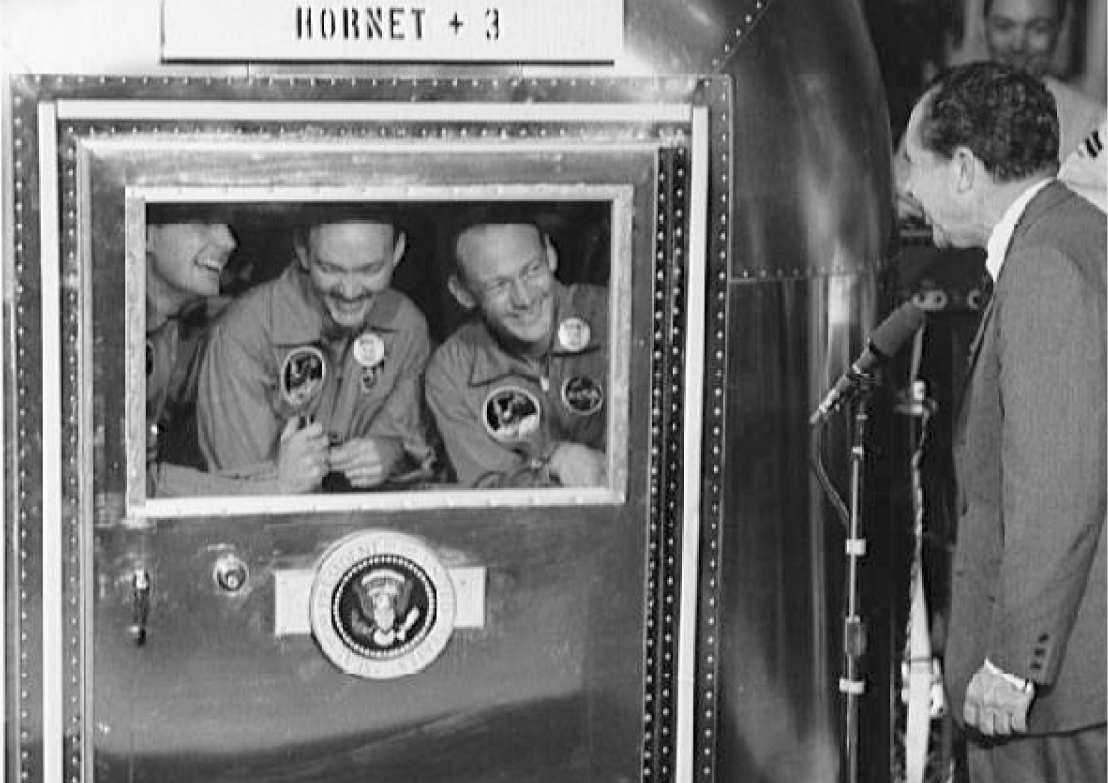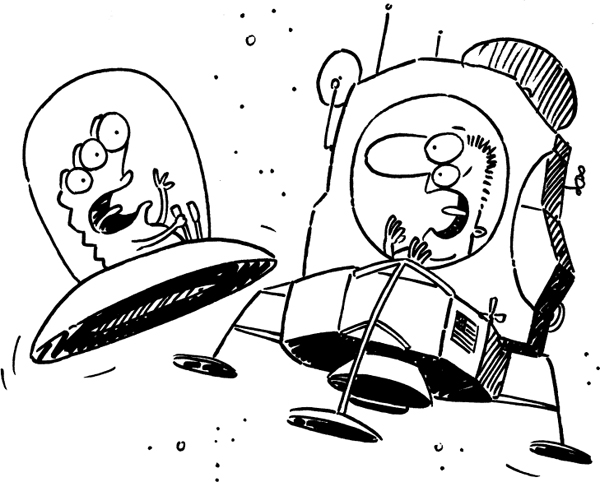For many people the most exciting part of the lunar landing was that first step onto the Moon. But for the astronauts and all the teams who were working with them, the real test was yet to come.
Would the Eagle be able to lift off safely from the Moon? There were no ground crews, no giant booster rocket. This was the most uncertain, and worrying, time of all. Would the rocket engine work?
Houston did not disturb the astronauts for seven hours and then gave them a wake-up call. After having a quick breakfast the astronauts began the final check before lift-off.
Everything seemed fine until Aldrin noticed that a switch had broken off — perhaps bumped when he put on his spacesuit.
It was the starting switch that turned on the engine to launch the landing craft! No switch meant no engine — no engine meant they were stranded on the Moon, with no help — and air that would last only a few more hours. (This piece of information was not released to the public.)
Technicians at Mission Control began to hunt frantically for a solution to the problem. Then suddenly someone realised that if you pushed a pen into the hole where the switch had been, you could turn on the engine!
It worked. The rocket launched the Eagle upwards in a spectacular seven-minute burst of flame, sending up billows of dust behind them — and toppling the flag that had been planted in the ground the ‘day’ before.
They had been on the Moon for 21.6 hours (lunar surface stay time).
Only Madrid was tracking the Eagle as it blasted up to meet the command module Columbia, although of course all of us at the other tracking stations were listening in on NET 1. Finally the two spacecraft docked. Suddenly, in Michael Collins’ words, ‘All hell broke loose.’ The docked spacecrafts began to jump and shudder as the two stabilisation systems conflicted with each other. Would something jolt loose in the confusion? Then the Eagle’s automatic pilot shut off, and there was silence.
Buzz Aldrin crawled through the hatch to the command module first, followed by Neil Armstrong, and then the three of them crawled back into the Eagle to retrieve the lunar samples — it needed the three of them to guide the samples safely through the tunnel without damaging anything.

President Richard Nixon welcomes Apollo 11 astronauts aboard the USS Hornet. The astronauts spent time confined to the Mobile Quarantine Facility.
NASA
As the spacecraft went behind the Moon again Michael Collins pulled down the switch to release the Eagle from the command module. The three men watched as it floated off into space. It would orbit the Moon, getting lower and lower until it crashed onto the lunar surface in four months’ time. The Eagle had taken the men to the Moon. Now it was space junk.
Honeysuckle Creek became the ‘prime station’ again. As I listened through my headset I could hear very little — the astronauts were having a meal. Once they’d finished they prepared the Columbia for the rocket engine burn that would take place behind the Moon. This would give them the thrust needed to break out of the Moon’s orbit and return home.
Once again, NET 1 was silent as the spacecraft disappeared behind the Moon for the last time. There would be no signal until Columbia edged out from behind the Moon. It was eerie to hear the voice channels so quiet, after all the chatter while the men were on the Moon.
Finally the signals reappeared, at the exact second we expected them, and after a period of frantic activity, Houston computers confirmed the correct trajectory — Columbia was on its way home.
On 24 July 1969, Armstrong, Aldrin and Collins splashed down in the Pacific Ocean — Apollo 11’s mission was accomplished.
And on the Moon, as well as the first footprints in the dust, rubbish from man’s first mission to another world, the fallen flag, the shattered rocks from the descent and launch, the harsh lunar sunlight shone on a plaque that said:
Here Men From Planet Earth First Set Foot Upon The Moon. July 1969 A.D. We Came In Peace For All Mankind.
(contributed by Colin Mackellar)
Honeysuckle Creek received the television pictures of Neil Armstrong’s first step on the Moon. Those TV pictures were seen all around the world, but first they had to be converted from NASA’s TV pictures to a kind which could be shown on normal television screens.
When the pictures were converted, the picture wasn’t nearly as clear as the original picture seen at Honeysuckle Creek. Nevertheless, viewers worldwide were thrilled to see the moon walk live.
The best quality TV picture was recorded onto tape at Honeysuckle Creek (and Parkes and Goldstone), and the tapes were shipped back to NASA’s Goddard Space Flight Center in the United States.
Thirty-five years after Apollo 11, some of the Honeysuckle Creek people thought they could find those tapes and then everybody could see the clear TV pictures, just as they had seen them at Honeysuckle Creek.
They asked NASA if they could borrow the tapes, but the tapes could not be found. A five-member tape search team was formed to look for them. It consisted of two Australians and three Americans. One of the Americans was Stan Lebar, whose team had designed and built the special TV camera used on the Moon in 1969.
The team, with NASA’s support, searched everywhere for the tapes. They looked in NASA’s different centres, and also tried to find records of what happened to the tapes.
During the Apollo program, all the signals sent from every Apollo mission were recorded at every tracking station. This added up to around 200,000 tapes. The TV footage of the Apollo 11 moon walk was on about a dozen of these tapes. Searches at the Goddard Space Flight Center didn’t find the tapes. No-one knew where they had gone.
Eventually, a paper record was found showing that they had been sent to the US National Archives near Washington for safe storage. Members of the team went looking there. After weeks of searching, they found empty shelves where the tapes had once been stored. Only one box had been accidentally left behind. So what had happened? Detective work discovered the sad story.
In the late 1970s, there was a worldwide shortage of magnetic recording tape, but NASA had many unmanned space missions which were sending important information back to Earth. All that information would be lost if it could not be recorded on tape. (In those days, hard disks did not hold much data, and there were no memory sticks — only tapes would do the job.)
Desperate to find tapes they could use, NASA withdrew the Apollo tapes from the archives. No-one had asked for them in years, so the decision was made to wipe and reuse them for the new missions. No-one thought those original recordings might be wanted again. And the tapes weren’t labelled as ‘Apollo 11 moon walk’, or anything else that would have marked them out as special.
The members of the tape search team were very sad that the tapes had been wiped and reused.
It wasn’t all bad news. When the Australian search team worked out what had happened, we suggested a plan to NASA. Even though the original tapes were gone, we’d found some very good copies of the converted TV footage everyone around the world saw in 1969 — including in the garage of one of the original Honeysuckle team — he’d found the old footage when cleaning out rubbish. The team suggested that NASA could get those recordings cleaned up by experts, and that’s what was done.
In 2009, Stan Lebar announced news of the restoration project at a NASA press conference, and the restored TV footage was released in 2010.
What is the moral of the story?
If you have important recordings that may be needed for generations to come, put a label on them so that everyone knows what they are, and why they should be kept safe! And then make a note of where you’ve kept them!
HAVE ASTRONAUTS EVER SEEN ANY ALIENS OR UFOS?
No. Some astronauts have reported seeing strange floating objects circling their spacecraft. But it has always turned out to be their garbage — or their frozen urine glittering in the sunlight!
Why haven’t astronauts seen any aliens or UFOs?

There are so many films and TV shows about aliens and UFOs that many of us believe that they must exist.
Aliens may exist in another solar system, so far away that we will never find them. They may look quite different from us — they might be more like plants or bacteria (or something even stranger). And UFOs are just that — Unidentified Flying Objects. If we were sure that there were flying saucers they wouldn’t be called ‘unidentified’!